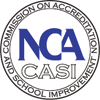
 |
|
Student Learning Goals
| Improvement Criteria | |
| PS 1 | The student learning goals are challenging, are appropriate in terms of rigor and diversity, meet student needs, and are consistent with the stated goals of the school program. |
Curriculum
| Membership Criteria | |
| PS 5 | The curriculum is based on student learning goals that reflect the school's statement of mission and goals. The curricular and co-curricular programs are designed to address student learning goals and to enhance student development in a variety of intellectual, personal, physical, and social modes and in career development. |
| PS 6 | Quality programs are accessible for all students. |
| PS 7 | The school meets the appropriate specialized curricular
requirements for each level of schooling.
|
| Improvement Criteria | |
| PS 9 | The resources of the community are utilized to support the curriculum. |
| PS 10 | The curriculum is broad in scope and designed to address the individual strengths, needs, and interests of the students served by the school. |
| PS 11 | The curriculum provides for equity of opportunity and diversity in learning activities to enable the school to meet student performance improvement goals. |
| PS 12 | The curriculum is developed, evaluated, and regularly revised by the professional staff with appropriate involvement by the school community. |
| PS 13 | Procedures that foster vertical and horizontal program articulation within the school and with affiliated schools are in place and operative. |
| Improvement Criteria | |
| PS 20 | Teachers use classroom practices which make the most productive use of instructional time. |
| PS 21 | The teaching-learning program is organized to allow each student to progress in a manner that is flexible and in accordance with individual development. |
| PS 22 | The teaching-learning program emphasizes the interrelationships among curricular areas. |
| PS 23 | Teachers employ a broad range of instructional techniques to take advantage of the varying intellectual strengths that exist within the student population. |
| PS 24 | Teachers use classroom practices and methodology consistent with current research. |
| PS 25 | The school uses the results of instructional assessments to press for higher levels of learning for all students. |
Staff Development
| Membership Criteria | |
| PS 30 | All school personnel are provided staff development commensurate with their assignment. |
| PS 31 | Staff development programs are designed through needs assessments with input from school personnel in planning and evaluating the programs. |
| PS 32 | Orientation is provided for all personnel new to the building. |
| Improvement Criteria | |
| PS 33 | A staff development plan is in place and staff development activities are connected to and supportive of the school's improvement plan. |
Assessment
| Membership Criteria | |
| PS 40 | Through written reports and individual conferences, parents are informed frequently and regularly about student progress. |
| PS 41 | The school uses a variety of measures including classroom and standardized measures to document the success of its students. |
| Improvement Criteria | |
| PS 42 | Assessment measures are congruent with the learning goals. |
| PS 43 | Students receive regular and frequent feedback on their progress. |
| PS 44 | Assessment of student learning is the primary indicator for documenting the effectiveness of the overall school program. |
| PS 45 | The school collects information from entering students to help establish a teaching-learning program that is ready to accommodate all learners. |
Pupil Personnel
Services
| Membership Criteria | |
| PS 50 | Pupil personnel services include but are not limited to counseling, appraisal, staff consulting, referral, and educational and career planning. |
| PS 51 | The school regularly conducts an inventory and diagnosis of students who have physical, social-emotional, mental, or academic characteristics that require specialized services, and the school participates in delivering these services. |
| PS 52 | The school has a well-planned health services program available to all students, including the services of a nurse. |
| PS 53 | The school has specified procedures to be followed in case of accidents, emergencies, and disasters. |
| PS 54 | The school has the necessary professional and support pupil personnel services staff to implement the program consistent with the needs of the student population. |
| PS 55 | Appropriate materials, facilities, and services are available throughout the school and/or district for students whose exceptional abilities, talents, or handicaps represent unique needs. |
| PS 56 | The school has a written description of the school counseling and guidance program specifying the guidance services performed and the personnel delivering these services. |
Student Activities
Program
| Membership Criteria | |
| PS 60 | The school maintains a diversified program of student activities as appropriate for the level of the students served by the school. |
| PS 61 | The student activities program is an integral part of the comprehensive educational experiences of students. |
| PS 62 | The scope of the student activities program is determined by the needs, interests, and abilities of students and is designed to contribute to the educational development of all students. |
| PS 63 | The school community provides the resources needed to support the student activities program. |
|
All material on this site © 2000-02 NCA Commission on
Accreditation and School Improvement unless otherwise noted. |
|